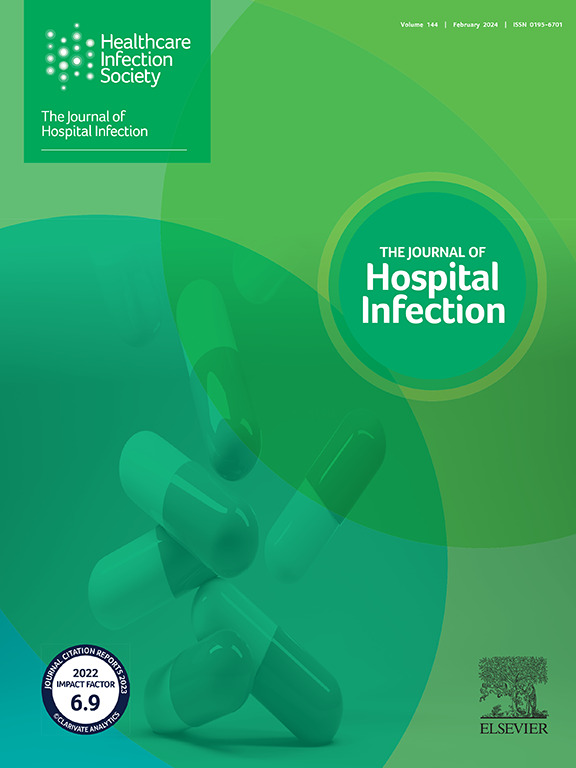SanibitTM电子手卫生系统提醒及激励措施对手卫生依从性的影响——一项前瞻性、四阶段观察性研究
IF 3.1
3区 医学
Q1 INFECTIOUS DISEASES
引用次数: 0
摘要
背景:我们的目的是在美国一家三级医院进行一项为期4期的前瞻性试验,通过个性化提醒和激励措施,全面评估sanibittm系统在ICU的实施情况,并研究这些干预对手部卫生依从性的影响。方法:在10张床位的神经内科重症监护病房安装手卫生自动监测系统。第一阶段:不提醒,现金奖励。第2a期:仅限照明,现金奖励。阶段2b:灯光+震动,现金奖励。阶段3:无需提醒,积分系统激励。第四阶段:灯光+震动,积分系统激励。结果:与直接观测相比,SanibitTM检测准确率为85.1%。只有灯光和现金奖励的阶段2a在一周中获得了最多的洗手机会。第4阶段有灯光、震动提醒和积分系统奖励的学生在完全、完全和部分遵守手部卫生方面表现最好,而第2a阶段只有灯光和现金奖励的学生在遵守手部卫生方面表现最好。快速进出房间事件的手卫生依从率显著低于进入房间事件的手卫生依从率,而长时间进出房间事件的手卫生依从率则相反。结论:手卫生机会、依从性和患者接触次数在不同的提醒/激励措施、卫生保健工作者个体、一周的日期和一天的时间之间存在显著差异。灯光和振动提醒以及积分系统激励达到了最佳的手部卫生依从性。临床试验注册:NCT03948672。本文章由计算机程序翻译,如有差异,请以英文原文为准。
Effects of reminders from Sanibit™ electronic hand hygiene system and incentives on hand hygiene compliance: a prospective, four-phased, observational study
Background
Individualized reminders and incentives from automated hand hygiene monitoring systems (AHHMSs) might contribute to significant hand hygiene improvement.
Aim
To comprehensively evaluate the implementation of the Sanibit™ AHHMS system in the intensive care unit and the impact of these interventions on hand hygiene compliance in a four-phased, prospective trial at a tertiary care hospital.
Methods
The Sanibit monitoring system was installed in a 10-bed neurological intensive care unit. Phase 1: no reminder, cash incentive. Phase 2a: lights only, cash incentive. Phase 2b: lights + vibrations, cash incentive. Phase 3: no reminder, point system incentive. Phase 4: lights + vibrations, point system incentive.
Findings
The accuracy rate detected by the Sanibit, compared with direct observations, was 85.1%. Phase 2a with lights only and cash incentives achieved the most hand hygiene opportunities in the middle of the week. Phase 4 with lights and vibrations reminders and point system incentives achieved the best in terms of total, full, and partial hand hygiene compliance, while phase 2a with lights only and cash incentives had the highest hand hygiene opportunities. Hand hygiene compliance rates of going-out room events were significantly lower than those of going-in room events for quick in-and-out room, while the opposite held true for long in-and-out room events.
Conclusions
Hand hygiene opportunities, compliance, and patient contact times varied significantly among different reminders/incentives, individual healthcare workers, day of the week and time of the day. Lights and vibration reminders and point system incentives achieved the best hand hygiene compliance.
求助全文
通过发布文献求助,成功后即可免费获取论文全文。
去求助
来源期刊

Journal of Hospital Infection
医学-传染病学
CiteScore
12.70
自引率
5.80%
发文量
271
审稿时长
19 days
期刊介绍:
The Journal of Hospital Infection is the editorially independent scientific publication of the Healthcare Infection Society. The aim of the Journal is to publish high quality research and information relating to infection prevention and control that is relevant to an international audience.
The Journal welcomes submissions that relate to all aspects of infection prevention and control in healthcare settings. This includes submissions that:
provide new insight into the epidemiology, surveillance, or prevention and control of healthcare-associated infections and antimicrobial resistance in healthcare settings;
provide new insight into cleaning, disinfection and decontamination;
provide new insight into the design of healthcare premises;
describe novel aspects of outbreaks of infection;
throw light on techniques for effective antimicrobial stewardship;
describe novel techniques (laboratory-based or point of care) for the detection of infection or antimicrobial resistance in the healthcare setting, particularly if these can be used to facilitate infection prevention and control;
improve understanding of the motivations of safe healthcare behaviour, or describe techniques for achieving behavioural and cultural change;
improve understanding of the use of IT systems in infection surveillance and prevention and control.
 求助内容:
求助内容: 应助结果提醒方式:
应助结果提醒方式:


